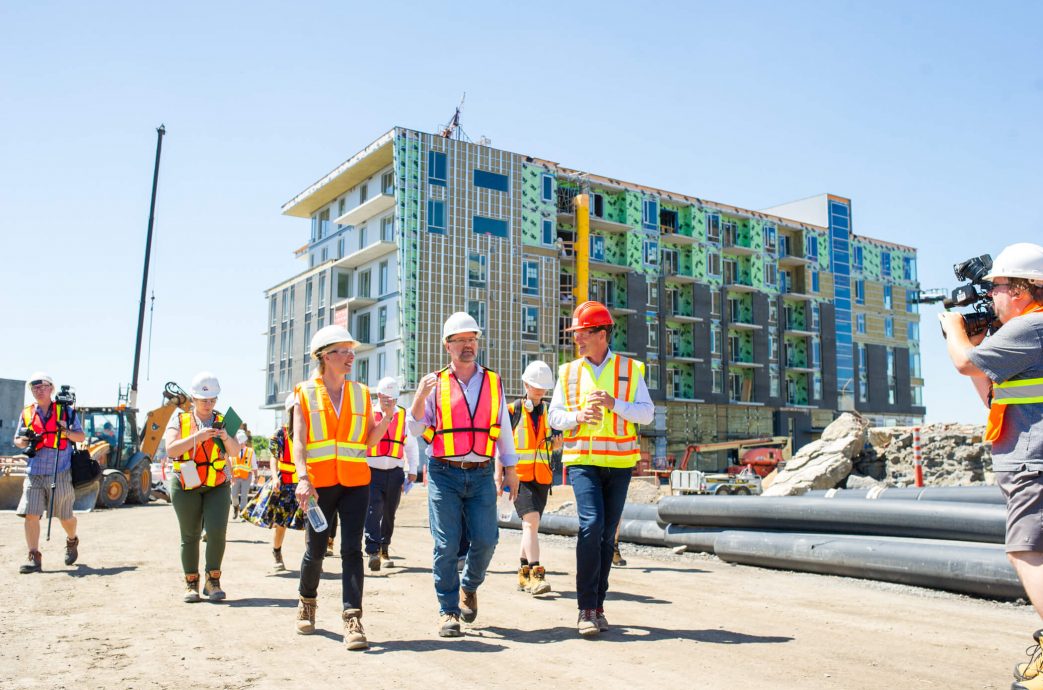When we set out to purchase the 37-acres of abandoned industrial brownfields in the heart of the nation’s capital, we knew that this would be a move that would generate a lot of excitement in our community, but that it would also bring with it many challenges and some controversy. After all, none of the efforts to develop this land in the years since Domtar had vacated the premises had been successful. Trying to bring consensus on a plan between two provinces, five governments and the three founding cultures is not something most developers relish. But we had a vision for our city, and we wanted to see it realized.
This property — a remnant of the industrial age, and a veritable barrier to our community’s access to the stunning Chaudière Falls — presented an unprecedented opportunity to take a desolate industrial wasteland and transform it into a world-class sustainability showpiece, a leading model for community-building that takes into account the realities of the 21st century.
We were fully aware that these lands are part of unceded Algonquin Anishinabe territory — as is most of Eastern Ontario and Western Quebec, including Parliament Hill — and that the Falls were significant to the Algonquin Anishinabe. We knew our plan to build on these lands might cause controversy, but we also knew that, if done right, these lands presented an opportunity of a lifetime to create a new model of collaboration between First Nation and non-First Nations in Canada.
This is why one of our first acts upon agreeing to purchase these lands in 2013 was to reach out to the Algonquin Anishinabe Nation. We wanted to be inclusive right from the start and make the Algonquin communities aware of our vision : to restore public access to the long hidden Chaudière Falls and create the world’s most sustainable community, right in the heart of the nation’s capital. Our message was that we would be achieving this in the most collaborative and beneficial way possible with the Algonquin Anishinabe people. Symbolically, the first formal meeting on the future Zibi site was with Algonquin leaders — the first time in at least a hundred years that an Algonquin leader had last set foot at the Falls.
Given the poisoned past, rebuilding the relationship between First Nations and non-First Nations is difficult. No doubt, we have had difficult conversations along our journey and we’ve faced controversy. But it is our hope that controversy will spark the social change required to improve relations between our cultures.
To see Zibi as simply condos is to miss the point; it’s much more ambitious than that. Zibi is a joint effort to make invisible people visible again.
Yes, it’s a bold thing to say that Zibi can help advance the relationship with Canada’s First Nations, even in its own small way. Many don’t believe us, or agree that this is the way forward. But this is genuinely what we seek to do.
We want to see Algonquin Anishinabe culture celebrated on the site. We want to create an antidote for the toxins of the past. We want Algonquin people to have a voice with Zibi. And we want all of this done in a way that delivers real and tangible benefits today and for future generations.
We’re getting there, one small step at a time (but making big waves). Zibi has led to real partnerships with the Algonquin Anishinabe and these partnerships have evolved to true friendships.
We were extremely honoured to learn that National Chief Perry Bellegarde said Zibi was a “shining example of relationship-building.” We were equally moved when the National Indigenous Council of Elders said Zibi was a positive step towards reconciliation.
We have conducted over the last three years the most inclusive and robust engagement program by a private developer with First Nations, certainly in Eastern Canada, and possibly in all of Canada, voluntarily surpassing any legal requirement to do so. We’ve met with Algonquin Anishinabe elders, leaders, communities, Bands and Councils, social service providers, youth, women and men. We’ve attended Listening Circles and presented to communities hours away in Ontario, and even further in remote parts of Quebec. We have reached out to all of the 11 Algonquin Anishinabe communities, the majority of whom had never been invited to participate, nor asked to participate, in consultations related to national capital region matters.
There is no clearly defined framework for First Nations engagement in this country; we have no roadmap for what we’re trying to do other than following our vision. While the courts have set out many of the elements that are required for proper consultation, the law is also clear and consistent that no such engagement is required for private land transactions. For example, all homes in Ottawa are situated on unceded Algonquin Anishinabe territory, yet homeowners and buyers have no obligation to consult with the Algonquin Anishinabe for that purchase to go through.
The Domtar property is 95 per cent private land, and the 5 per cent that is public does not overly impact the redevelopment plans for Zibi. As such — and as unbelievable as it may seem for such a significant piece of land in the heart of the nation’s capital — we could have proceeded without engaging any First Nations people. Yet we didn’t.
This would go against our vision of creating a new model of collaboration between First Nation and non-First Nations in Canada. We are the only private developer to have publically acknowledged that Zibi, as well as a good part of Quebec and Ontario, is on unceded Algonquin territory. Zibi will clearly reflect this fact.
We chose to extend a hand in friendship to the Algonquin Anishinabe people and many have accepted it, leading to unprecedented initiatives in this part of Canada. Already these are delivering real and lasting benefits to communities.
We have also entered into partnerships with a number of Algonquin communities, businesses and individuals, all of whom are agents of positive change looking to play their part in the rebuilding of a new relationship between First Nation and non-First Nations.
Above all, we see hope and possibility. We see that a collaboration and a joint approach to community building, where our two cultures work together to bring back the Algonquin Anishinabe voice and culture in the heart of the nations’ capital, is possible.
It remains to be seen if we’ll be successful, but our approach is rooted in collaboration rather than division — and we are convinced it’s the new approach that is needed now and that will become a model for First Nations and non-First Nations across the country.
The federal and provincial governments refused to buy these lands. As a private developer, we saw an opportunity to use this magnificent property and to develop it in a way that is meaningful for First Nations, for our community, for our country, and for our planet.
The time is now for a bold vision. One that is positive and productive. One that is a small step towards reconciliation.








